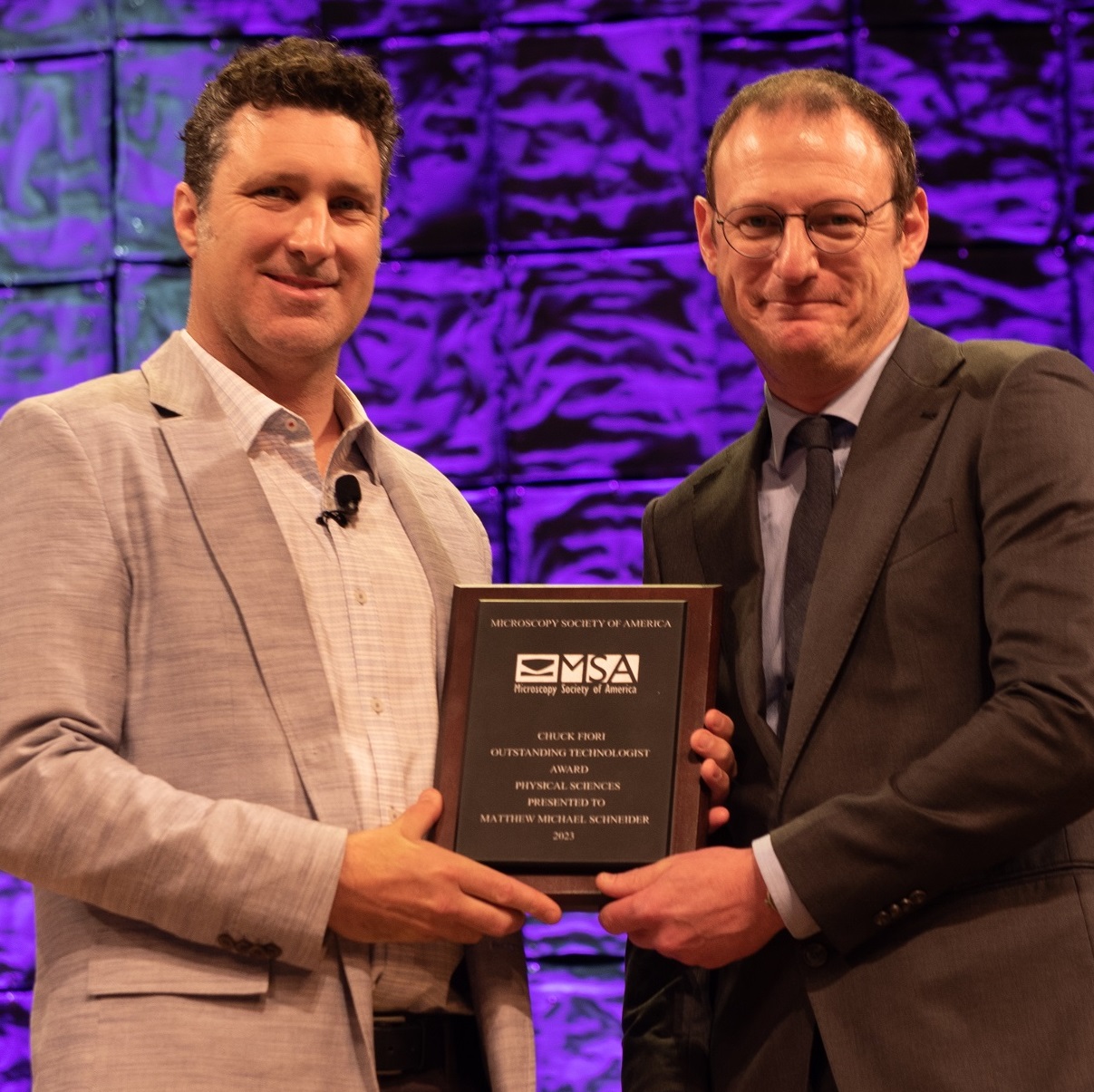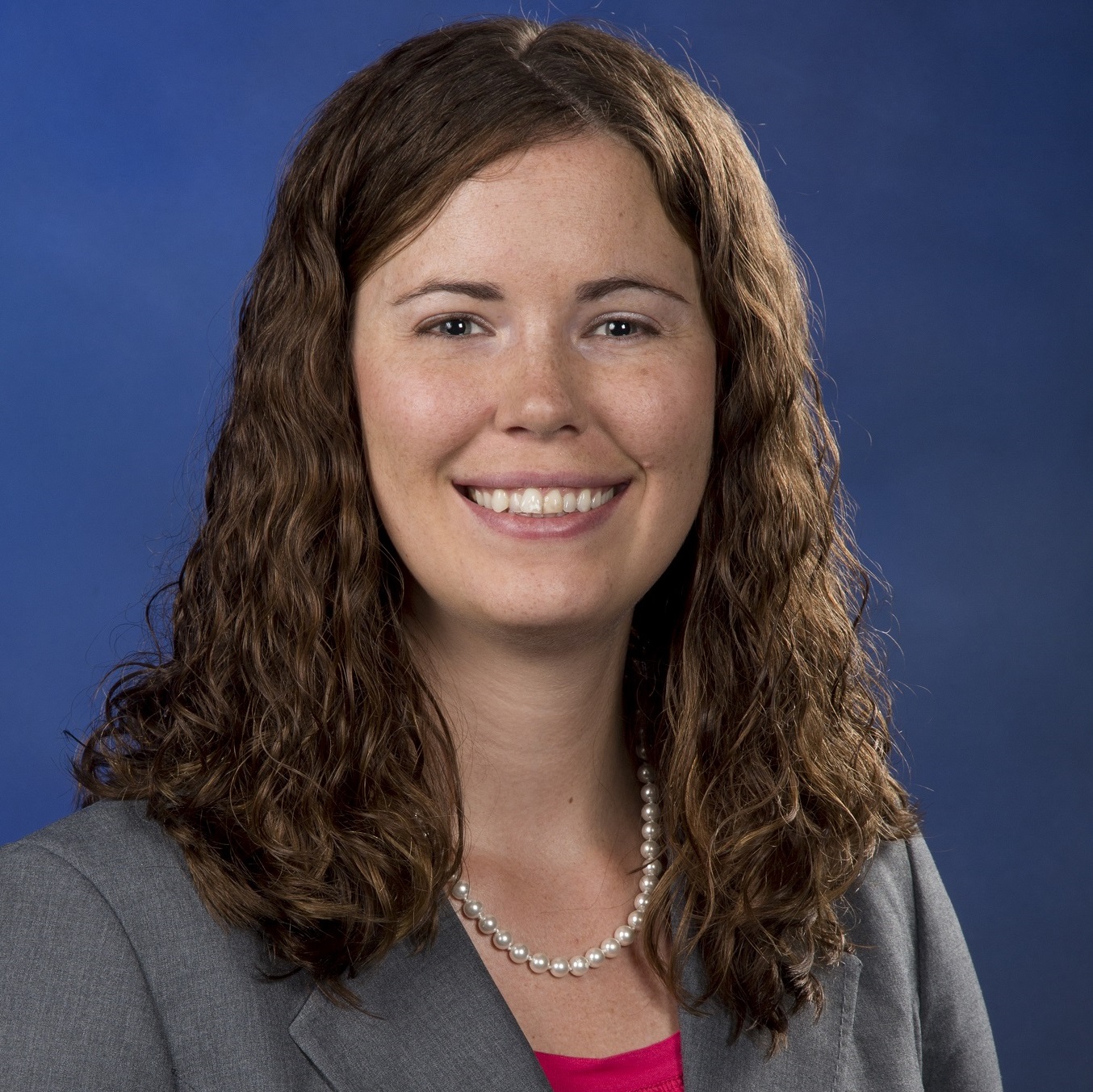STE Highlights, October 2023
Awards and Recognition
Earth and Environmental Sciences
Innovative inverse analysis embeds physics to characterize subsurface structures
Materials Physics and Applications
New book showcases versatility, robustness of popular materials modeling code
Strain manipulation tunes TaSe3 quantum mechanical behavior
Studying microstructure in steel subjected to dynamic loading conditions
Awards and Recognition
Schneider earns Chuck Fiori Award for Outstanding Technologist in the Physical Sciences
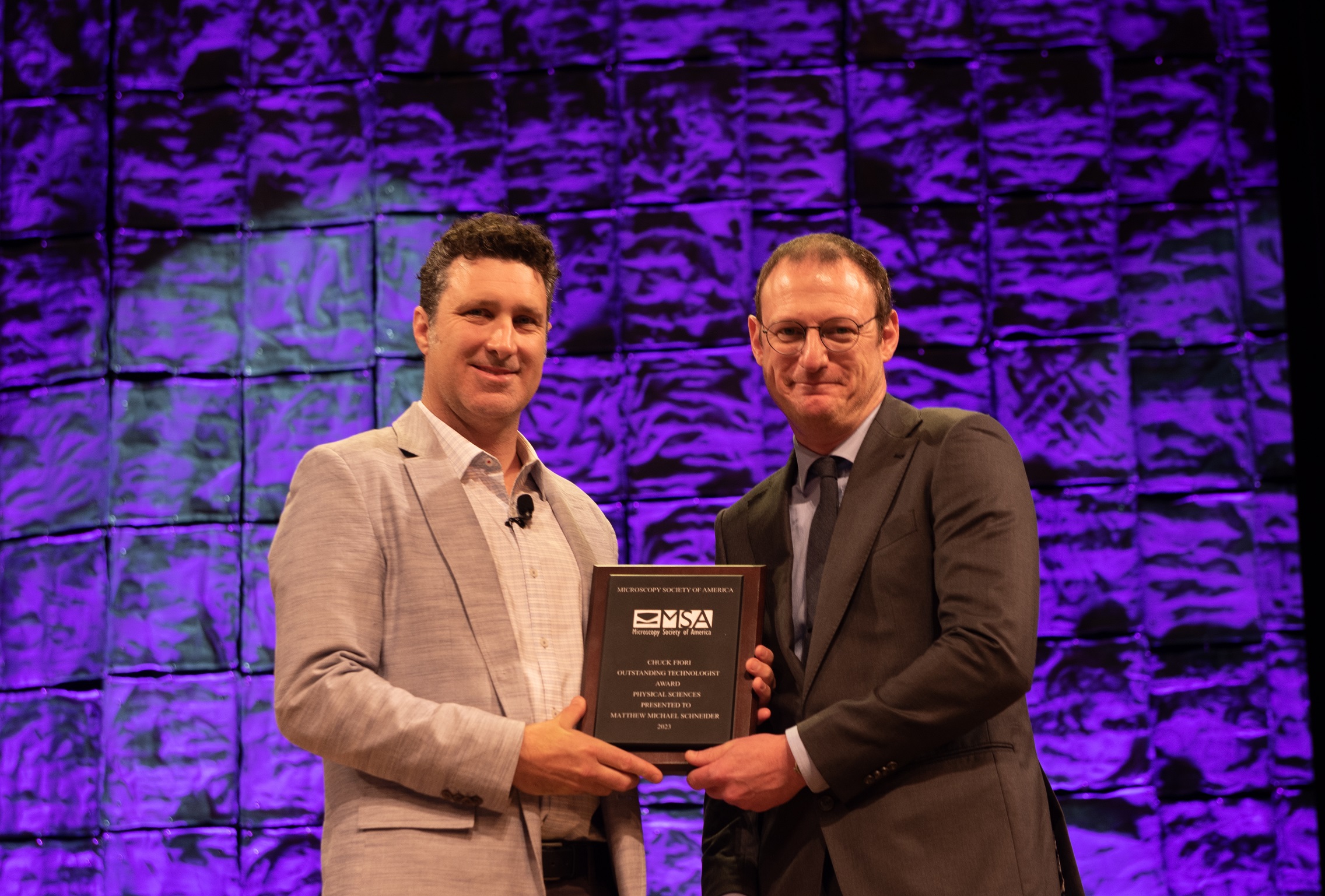
Matthew Schneider
Matthew Schneider, a research technologist in the Materials Science in Radiation and Dynamics Extremes (MST-8) group at Los Alamos National Laboratory, has been selected as this year’s Chuck Fiori Award winner as an Outstanding Technologist in the Physical Sciences from the Microscopy Society of America. The annual award “honors a technologist from the Physical sciences who has made significant contributions, such as the development of new techniques that have contributed to the advancement of microscopy and microanalysis.”
Schneider is a materials scientist and electron microscopist focused on the characterization of materials from the micro- to the Ångstrom-scale. The Microscopy Society of America’s citation noted Schneider “enjoys bringing advanced microscopy methods to a challenging array of problems in modern materials science.” His professional interests include measuring and understanding dynamical material responses to applied stimuli including changes in elemental distribution, crystal structure, strain state, electronic structure and more. He is currently working towards the application of machine learning-based inferences to augment in situ experimentation and characterization efforts in the transmission electron microscopes in the Electron Microscopy Lab at Los Alamos. He is also contributing to the development, implementation and analysis of highly data-rich 4D-STEM datasets.
In his current role in MST-8, Schneider is one of four staff members who run Los Alamos’ Electron Microscopy Laboratory. He is primarily responsible for the capability development, operation, training and maintenance of the EML’s transmission electron microscopes. He is also leading the procurement, installation, and commissioning of the Laboratory’s new $6 million probe-corrected Spectra Ultra S/TEM — a scanning transmission electron microscope — that is expected to be operational in 2024.
Schneider received his bachelor’s degree in materials science and engineering from Purdue University in 2011 and his master’s degree in materials science and engineering from the University of Virginia in 2014 where his dissertation work focused high-resolution observations of in situ of alloy solidification. He joined Los Alamos in 2017 where his initial efforts focused on the successful installation and commissioning of the Scios 2 FIB/SEM microscope and the Themis G3 probe-corrected S/TEM microscope currently operational in PF400.
Yablinsky receives ASM Silver Medal Award

Clarissa Yablinsky
Clarissa Yablinsky, with the Nuclear Materials Science group, MST-16, at Los Alamos National Laboratory, has earned the Silver Medal Award from ASM International, the world’s largest materials science and engineering society. Awarded to midcareer members for distinguished contributions to the society and to the field of materials science and engineering, the Silver Medal Award seeks “to recognize leadership at an early stage and encourage individuals to grow, nurture, and further contribute to the growth of the profession, as well as the society.” Yablinsky was cited “[for] excellence in materials research and development supporting the nuclear deterrent and advanced nuclear energy and tireless volunteerism for the profession and STEM outreach.”
A scientist and team leader, Yablinsky’s research focuses on understanding structure-property relations, specifically mechanical behavior, of plutonium and plutonium alloys across multiple strain rates and temperature regimes. She has made many impactful contributions to both basic and applied plutonium science at the Laboratory, leading Level 2 milestones reporting on mission-critical work and producing more than 50 publications, including contributions in the 2nd edition of the Plutonium Handbook. She has been part of a Laboratory Distinguished Performance Team award and has received three National Nuclear Security Administration Defense Programs Award of Excellence for her role on projects. Throughout her career she has been a mentor to staff members, postdoctoral fellows and students. Yablinsky has been an active member of ASM International, participating in numerous national level committees, as well as serving in various positions within the local ASM chapter.
Yablinsky received her doctoral degree in materials science and engineering from the Ohio State University in 2010, where her research focused on fatigue crack growth in nickel-based superalloys. She performed postdoctoral research at the University of Wisconsin, characterizing damage structures in nuclear fuel, and at Los Alamos, investigating processing-structure-properties of steel and uranium alloys. She received a master’s degree from the Ohio State University and a bachelor’s degree from Carnegie Mellon University, both in materials science and engineering.
Bioscience
Paper explores challenges and benefits of fungal microbiome research
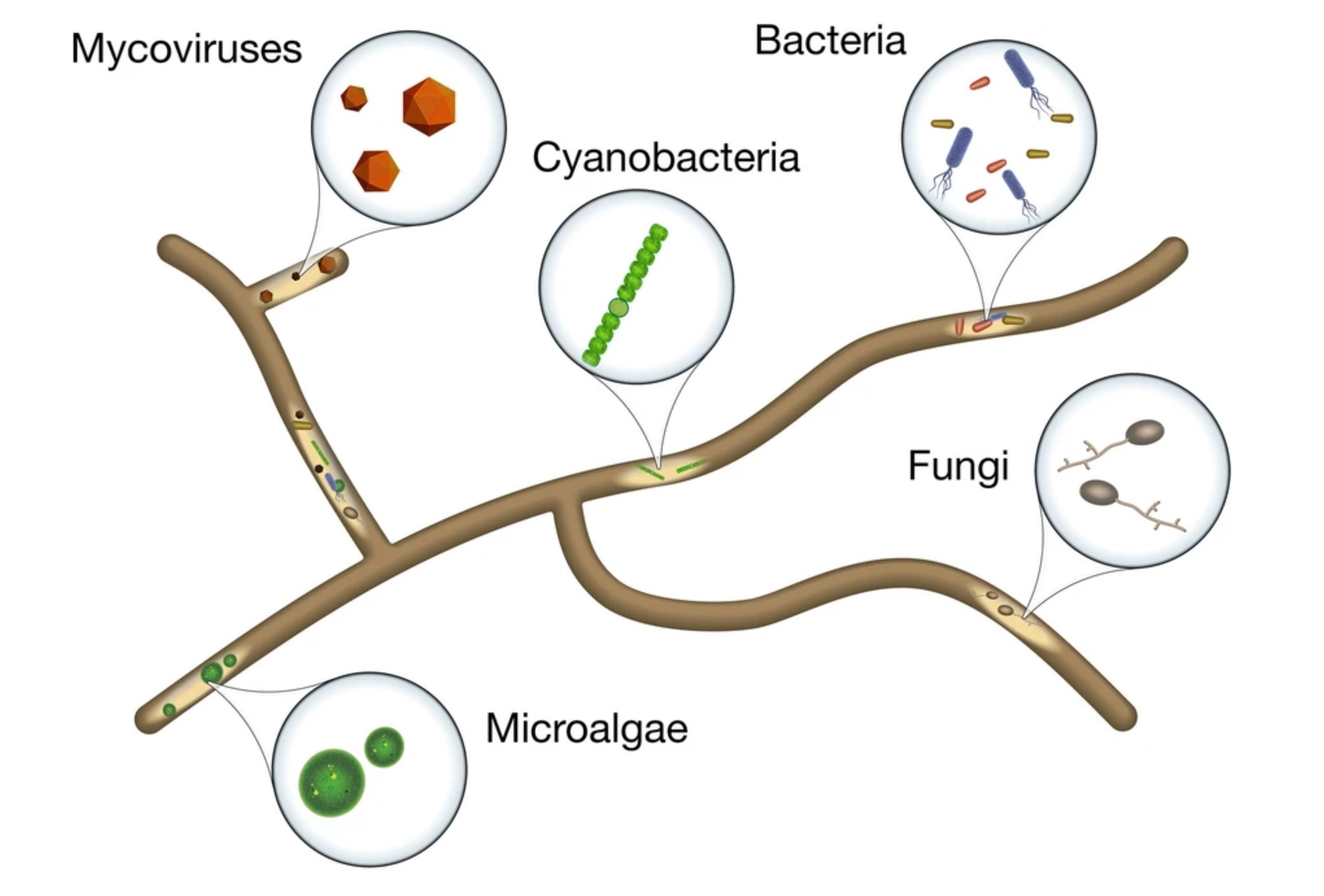
The endohyphal microbiome is known to include microalgae, mycoviruses, bacteria, cyanobacteria and fungi. Image published in Microbiome and used via Creative Commons license.
Scientists in the Genomics and Bioanalytics Group (B-GEN) published a review article based on their work in BioMed Central journal, Microbiome. The paper, “The endohyphal microbiome: current progress and challenges for scaling down integrative multi-omics microbiome research,” explores the discovery that fungi, which reside in most environments including on and within human and other animal (and plant) hosts, actually have entire communities of other microorganisms living inside them.
Fungi are abundant in the planet’s myriad ecosystems, but to date they have been studied far less frequently or thoroughly than bacteria and viruses. As a result, this concept of “microbiomes within microbiomes” is even more difficult to investigate because of the lack of baseline understanding of fungi as well as a lack of tools, techniques and standardization for investigating intracellular microbiomes. The authors discuss the challenges associated with endohyphal (within fungi) microbiome research including sample extraction, sample preparation, multi-omic data generation, and multi-omic data analysis and integration of these data, and how advancing this area of research could benefit and provide greater insights into the overall studies of all microbiomes. This review of the current status of the field provides a baseline for this growing area of interest and a roadmap for future explorations of this microscopic world.
Published with the paper is a video abstract developed by Microbiome; the video highlights research techniques and the challenges associated with studying fungal microbiomes.
Reference
“The endohyphal microbiome: current progress and challenges for scaling down integrative multi-omic microbiome research,” Microbiome, 11 (2023); DOI: 10.1186/s40168-023-01634-7. Authors: Julia M. Kelliher, Aaron J. Robinson, Reid Longley, Leah Y. D. Johnson, Buck T. Hanson, Demosthenes P. Morales and Patrick S. G. Chain (Los Alamos National Laboratory); Guillaume Cailleau and Pilar Junier (University of Neuchâtel, Switzerland) and Gregory Bonito (Michigan State University).
Funding and mission
This research was supported by the U.S. Department of Energy, Office of Science, Biological and Environmental Research program and Biological System Science Division. The work supports the Global Security mission area and the Complex Natural and Engineered Systems and Science of Signatures capability pillars.
Technical contact: Julia M. Kelliher (B-GEN)
Earth and Environmental Sciences
Innovative inverse analysis embeds physics to characterize subsurface structures
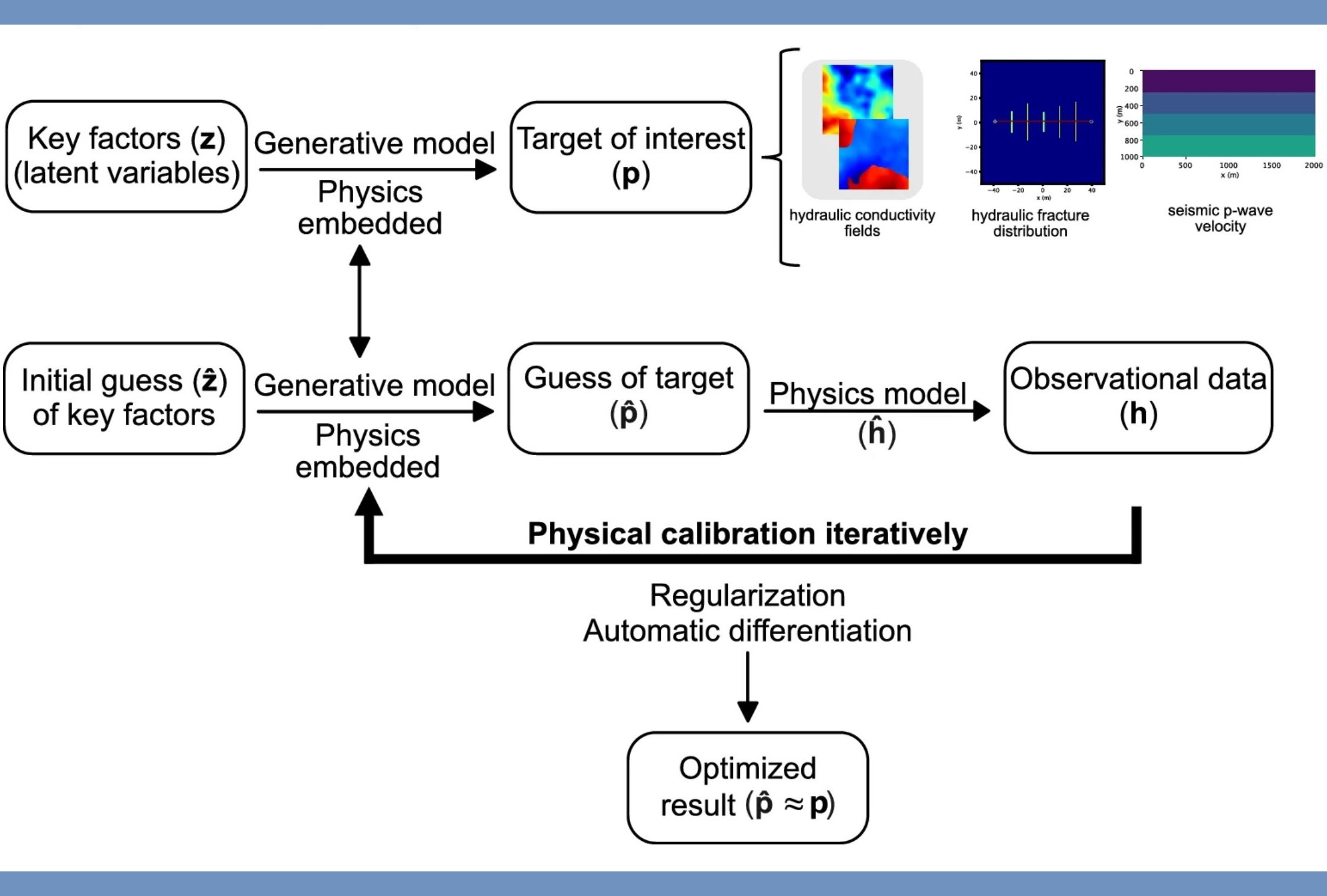
To represent the physics-embedded feature, an inverse analysis, described in the second row, has a generative model applied. Optimization is made simple by the application of regularization and algorithmic differentiation. Figure published in Scientific Reports and used via Creative Commons license.
Understanding fluid flows in underground reservoirs in oil field settings means figuring out complicated subsurface structures, such as hydraulic fractures. But scarce data and spatially varying geological structures make fluid flows hard to characterize. An Earth and Environmental Science team at Los Alamos recently applied a physics-embedded inverse analysis with algorithmic differentiation to generate clear subsurface images from noisy, complex data. The team’s results were recently described in Scientific Reports, a Nature journal, as well as in the Journal of Machine Learning for Modeling and Computing.
The inverse analysis works backwards to infer properties (e.g., unknown underground geological properties) by combining observational data, such as seismic data or fluid pressure data, with physics-embedded numerical, generative models. In the research reported in Scientific Reports, the team, including postdoctoral researcher Hao Wu, DOE fellow Sarah Greer and team leader Daniel O’Malley applied physics-embedded inverse analysis to two heterogeneous hydraulic conductivity fields, a hydraulic fracture network, and a seismic inversion for P-wave velocity. The combination allowed the team to generate clear subsurface images from noisy, complex data.
In research described in the Journal of Machine Learning for Modeling and Computing, a Los Alamos team led by Wu developed and tested the RegAE analysis approach, which provided an efficient method where the parameter fields are high-dimensional and have different heterogeneous structures. The novel inverse analysis method used a physics-embedded generative model matching observational data for various geological problems related to heterogeneous hydraulic fields. As part of that method, the team also evaluated different neural networks — a shallow, dense network and a deep, convolutional network — to understand their application with a technique known as a variational autoencoder and to analyze their performance.
The results proved the physics-embedded inverse analysis method is computationally efficient, easy and fast, and it consistently and accurately characterizes subsurface geological problems. The core of this method is to include the physical understanding of the underground structures directly in the inverse model. Doing so makes this method invulnerable to a class of problems that plague machine learning methods (akin to adversarial examples), which are currently fashionable. This method opens new doors for exploring more complicated and realistic geologic research problems, important because understanding underground geology and fluid flow is critical to energy production, prediction, optimization, reservoir characterization, groundwater resources management and subsurface contaminant remediation. Hydraulic fracture simulation has become a significant part of the design and analysis of oil fields through reservoir characterization and simulation.
References
“Physics embedded inverse analysis with algorithmic differentiation for the earth’s subsurface,” Scientific Reports, 13, 718 (2023); DOI: 10.1038/s41598-022-26898-1. Authors: Hao Wu and Daniel O’Malley (Los Alamos National Laboratory), Sarah Greer (Massachusetts Institute of Technology).
“Inverse analysis with variational autoencoders: A comparison of shallow and deep networks,” Journal of Machine Learning for Modeling and Computing, 3, 2, 47 (2022); DOI: 10.1615/JMachLearnModelComput.2022042093. Authors: Hao Wu, Daniel O’Malley, John K. Golden, Velimir V. Vesselinov (Los Alamos National Laboratory).
Funding and mission
This research was supported by the Laboratory Directed Research and Development’s Early Career Research program. The work supports the Energy Security mission area and the Information Science & Technology capability pillar.
Technical contacts: Hao Wu and Daniel O’Malley (EES-16)
Study illuminates influence of fungi on plant functions

Neutron radiography imaging of water transport in roots of drought tolerant pinyon genotypes. The pinyon on the left was inoculated with sterile inoculum and the one on the right with live inoculum. Drought intolerant pinyon genotypes (not shown) were also inoculated with live fungi and a sterile inoculum and measured. The experiment’s results revealed that the fungus beneficial to water uptake in the drought tolerant seedlings was detrimental to water uptake in the drought intolerant seedlings.
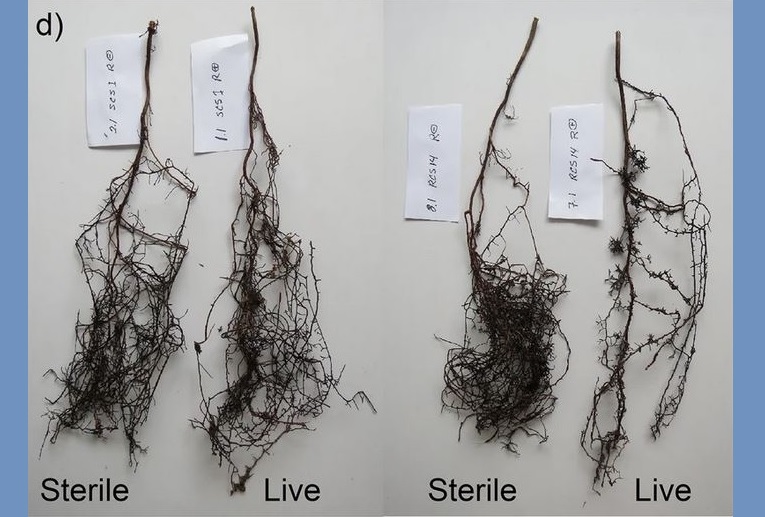
Bearing witness to the influence of fungal colonization, at left, the root systems of sterile and live inoculated drought-tolerant seedlings, and at right, the root systems of sterile and live inoculated drought-intolerant seedlings. Published in Scientific Reports and used via Creative Commons license.
In a study published in Scientific Reports, a Nature journal, lead author Sanna Sevanto (EES-14) reports the influence of fungi on the ability of plants to uptake water from the soil. These results are a first demonstration of the significant and opposite effects that microorganisms can have on important plant functional traits like stomatal control of desiccation. Conducted with drought tolerant and intolerant genotypes of pinyon pine, the study examined the traits associated with differential mortality and growth in nature. The study’s results highlight the importance of appropriate plant genotype and microbial associate pairings for mitigating climate change impacts on vegetation.
The team treated plants with live or sterile inoculum and tracked and compared the in-situ root and rhizospheric water uptake with neutron radiography. Team members from the Materials Science and Technology division supported the neutron radiography, in which a particle accelerator at the Los Alamos Neutron Science Center provided real-time imaging of the heavy water movement inside the plant or soil. Transpiration, ectomycorrhizal fungi root colonization and drought-tolerance-related plant traits (above- and below-ground) were also measured. The team found that fungi colonization improved water uptake among drought-tolerant pinyon but, surprisingly, did not improve water uptake, but actually reduced it among drought-intolerant pinyon.
Ultimately, the plant genotype makes a difference for the ectomycorrhizal fungi’s effect on traits such as water transport and uptake, carbon allocation and stomatal closure point. The results may point the way toward improving drought tolerance with microorganisms that can improve plant performance. For some plant species, pairing with a specific, genotype-level microorganism could impact functional traits such to improve drought tolerance.
Funding and mission
This study was funded by the Laboratory Directed Research and Development program at Los Alamos. The work supports the Global Security mission area and the Complex Natural and Engineered Systems capability pillar.
Reference
“Benefits of symbiotic ectomycorrhizal fungi to plant water relations depend on plant genotype in pinyon pine,” Scientific Reports, 13, 14424 (2023); DOI: 10.1038/s41598-023-41191-5. Authors: Sanna Sevanto, Max G. Ryan, Adrian S. Losko, Sven C. Vogel, Kelsey R. Carter, L. Turin Dickman, Michelle A. Espy and Cheryl R. Kuske (Los Alamos National Laboratory); Catherine Gehring and Adair Patterson (Northern Arizona University).
Technical contact: Sanna Sevanto (EES-14)
Materials Physics and Applications
New book showcases versatility, robustness of popular materials modeling code

Carlos Tomé (left) and Ricardo Lebensohn (right)
Long-time scientific collaborators Carlos Tomé (MST-8) and Ricardo Lebensohn (T-3) have co-authored a new book that highlights the theoretical and practical applications of plasticity simulations. “Materials modeling with the visco-plastic self-consistent approach: Theory and practical applications,” published by Elsevier, condenses 30 years of research done by the authors and collaborators.
Hundreds of researchers worldwide have employed their approach and associated computer code, which they developed in 1993 as a means to simulate the plastic deformation of polycrystalline materials. Their original visco-plastic self-consistent (VPSC) approach paper in Acta Metallurgica et Materialia has been cited more than 2200 times. The new book, aimed at researchers in mechanical engineering and materials science and students in these disciplines, provides readers with a foundational understanding of polycrystal plasticity and details the authors’ VPSC formulation. It also describes its computational realization — the open-source VPSC code — together with practical simulations illustrating the code’s capabilities, including hardening and texture evolution, twinning transformation, creep response, and irradiation effects in metallic and geologic systems of different symmetries.
The ability to predict the mechanical response of a material based on its microstructure and its evolution during plastic deformation is key in many technologies, including mission-relevant applications at the Laboratory. VPSC has been adapted for use in a variety of research projects at Los Alamos. These include for programs as diverse as DOE’s Basic Energy Sciences program, the DOE’s Nuclear Energy Advanced Modeling and Simulation program, the Consortium for Advanced Simulation of Light Water Reactors, and Los Alamos’s Laboratory Directed Research and Development times.
Tomé is a pioneer in the theoretical and numerical development of physically based models of mechanical behavior of polycrystals. In recognition of his contributions to the field, he was named a Laboratory Fellow and is the recipient of the International Journal of Plasticity’s Khan International Award and Cyril Stanley Smith Award, given by the Minerals, Metals and Materials Society (TMS). Tomé, who has a doctoral degree in physics from the National University of La Plata, Argentina, joined the Laboratory in 1996.
Lebensohn is an expert in the structure-property relationship of materials and crystal plasticity modeling. In recognition of his contributions to the field, he was named a Laboratory Fellow and is the recipient of the Alexander von Humboldt Foundation’s Humboldt Research Award and the TMS Structural Materials Division’s Distinguished Scientist/Engineer Award. Lebensohn, who has a doctoral degree in physics from the National University of Rosario, Argentina, joined the Laboratory in 2003.
Funding and mission
The work supports the Laboratory’s Energy Security and Nuclear Deterrence mission areas and the Materials for the Future and Information, Science and Technology capability pillars.
Reference
“Material modeling with the viscoplastic self-consistent (VPSC) approach: Theory and Practical Applications,” Elsevier Inc. (2023); DOI: 10.1016/C2019-0-01217-4. Authors: Carlos N. Tomé and Ricardo A. Lebensohn (Los Alamos National Laboratory).
“A self-consistent anisotropic approach for the simulation of plastic deformation and texture development of polycrystals: Application to zirconium alloys,” Acta Metallurgica et Materialia, 41, 2611 (1993); DOI: 10.1016/0956-7151(93)90130-K. Authors: R.A. Lebensohn and C.N. Tomé (National University of Rosario, Argentina).
Technical contacts: Carlos Tomé (MST-8) and Ricardo Lebensohn (T-3)
Strain manipulation tunes TaSe3 quantum mechanical behavior
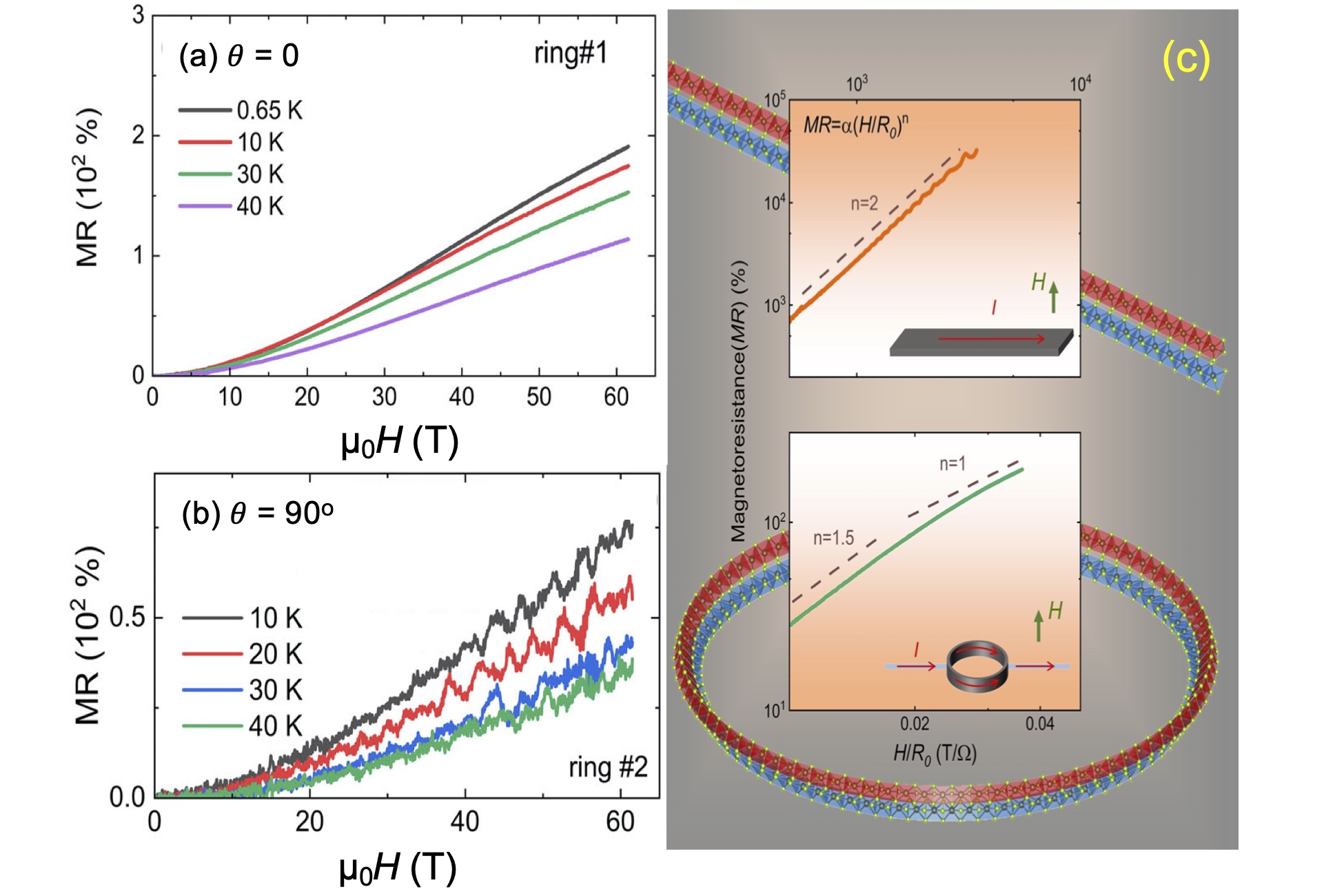
Magnetoresistance (MR, i.e. percentage change in electrical resistance due to magnetic field) of two TaSe3 devices measured using magnetic fields of up to 60 T [Figures (a) and (b)]. Figure (b) shows the unusual quantum oscillations, which are periodic in field. Compared to unstrained ribbons, the MR in the ring-shaped devices is a factor thousand smaller. The scaled logarithmic plots in (c) show that the MR in the rings (lower) and ribbons (upper) have different power-law dependences on the field. The field dependence of MR is a key indicator of underlying topology. The orange and blue symbols show the chains of molecules in the rings and unstrained ribbons schematically.
Recent research at the National High Magnetic Field Laboratory measuring the electrical resistance of ring-shaped TaSe3 devices suggests a way to tune the quantum-mechanical behavior of electrons, potentially offering apathway toward very receptive sensors and devices.
Theoretical calculations have suggested that the topological properties of TaSe3 are controllable by strain. The research team, including current Los Alamos postdoctoral research associate Joanna Blawat (formerly at Louisiana State University and the University of South Carolina) and MAGLAB physicist John Singleton, tested this experimentally by bending ribbon-like TaSe3 single crystals into ring-shaped devices, thus introducing strain. Under magnetic fields of up to 60 T provided by the Pulsed-Field Facility in Los Alamos, the team found that the resistance of the devices exhibited unconventional curvatures as a function of field at different temperatures. Quantum oscillations showing a very unusual periodicity were also observed in the resistance.
Unstrained, ribbon-shaped TaSe3 crystals were also tested. Their resistance behaved very differently as a function of field and did not exhibit any of the exotic behavior of the rings. The contrast demonstrates the viability of using strain to tune the topological properties of low-dimensional materials. Detecting topological changes and other quantum-mechanical behavior is most reliably done by measuring material properties in high fields. Devices that work on quantum principles, including quantum computers and sensors, could see their development furthered by an understanding of how to control topological behavior.
Chosen as a spotlight article in the September issue of Cold Facts, the international magazine of the Cryogenic Society of America, the research was first described in the journal Advanced Quantum Technologies. It was underpinned by pulsed-field measurements done at Los Alamos by Blawat and Jon Singleton.
Funding and mission
This work was supported by the U.S. Department of Energy, including the Basic Energy Sciences program “Science at 100 T” and the National Science Foundation. A portion of this work was performed at the National High Magnetic Field Laboratory, which was supported by the National Science Foundation, the State of Florida and the DOE. The work supports the Global Security mission area and the Materials for the Future capability pillar.
Reference
“Manipulation of the Magnetoresistance by Strain in Topological TaSe3,” Advanced Quantum Technologies, 5, 12, 2200094 (2022); DOI: 10.1002/qute.202200094. Authors: Jie Xing, Joanna Blawat, Ahmad Ikhwan Us Saleheen, Rongying Jin (University of South Carolina); Smita Speer (Louisiana State University); John Singleton (Los Alamos National Laboratory).
Technical contact: John Singleton (MPA-MAGLAB)
Studying microstructure in steel subjected to dynamic loading conditions

An illustration depicting how a material’s microstructure influences its spall strength and damage characteristics. At left: Micrographs of (from top) ferrite-pearlite (FP), martensite (M), and spheroidized 1045 steel (SPH). In summary, the illustration shows that overall damage increased in the order M>SPH>FP in the same material (chemically) as the crystal structure fraction was modified.
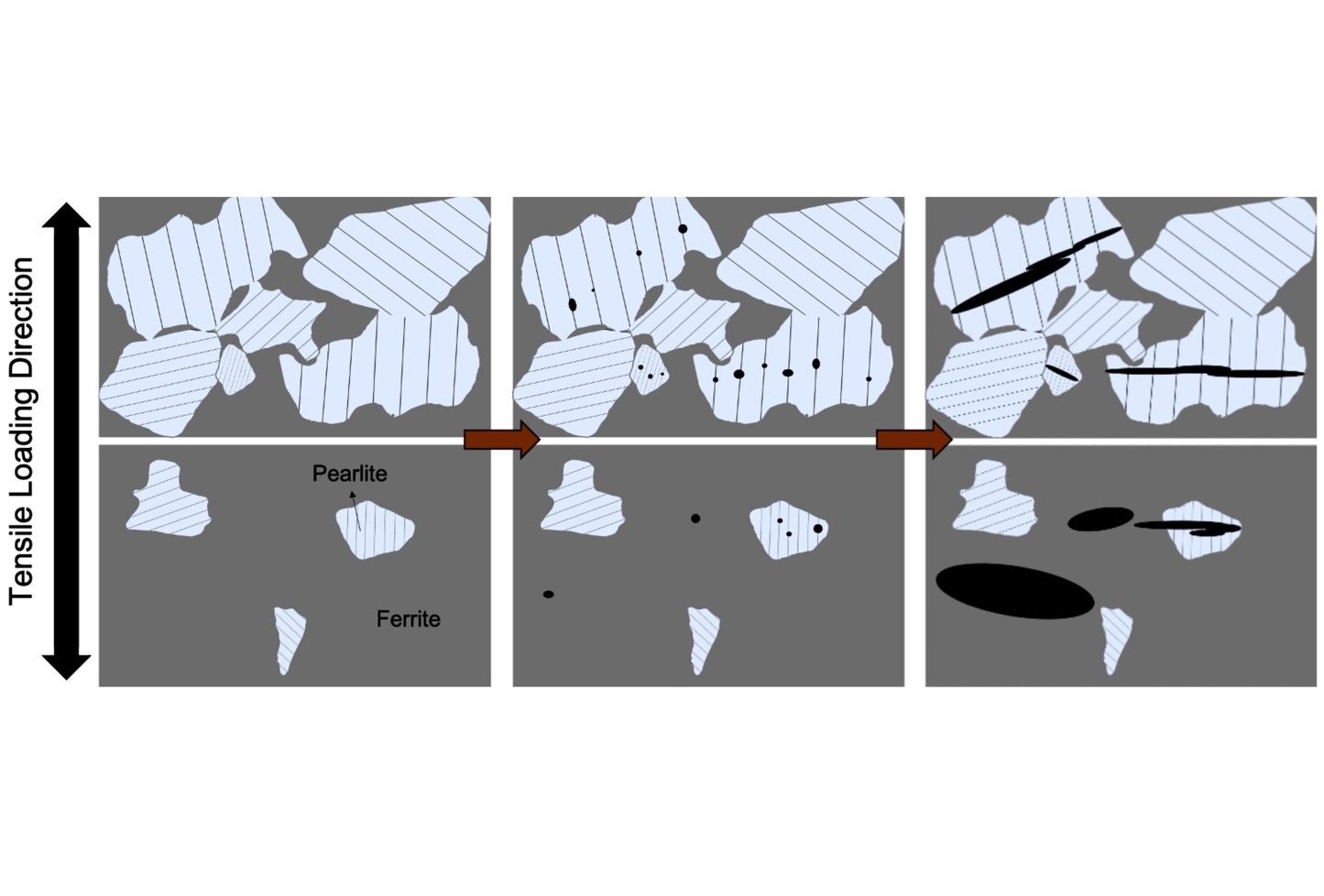
A schematic of damage evolution in ferrite-pearlite microstructures with relatively high (top) and low (bottom) pearlite fractions. The illustration clearly shows that pearlite phase is relatively brittle and not only acts as a void nucleation site but also encourages void growth—suggesting that introduction of pearlite phase in a steel should be avoided if a material is meant to be more resistant to damage.
Los Alamos researchers recently introduced multiple crystal structures, or phases, by heat treating steel — one of the world’s most commonly used materials — to better understand the effect microstructure has on the material’s response to shock loading. Their work revealed how microstructure influences spall strength — the resistance of a material to nucleate voids/damage during shock loading — and the resulting damage characteristics.
Understanding how a material’s microstructure affects its performance is essential to strategically design materials for specific applications. It is especially critical in engineering materials expected to withstand extreme conditions, including those found in aerospace, automotive, and defense applications.
In work selected as an Editor’s Pick in Journal of Applied Physics, the researchers explored the shock response of two plain carbon steels with varying ferrite-pearlite fractions. This alloy is widely used in engineering applications due to its low cost and its balance of strength and ductility. The team’s work revealed that pearlite phase leads to a reduction in the overall spall behavior in such materials and further clarifies the influence of relatively brittle, second-phase particles on dynamic deformation.
In their second publication on this topic, in Acta Materialia, the researchers investigated the spall strength and damage behavior of three common steel microstructures where the crystal structure/phase fraction was again modified using various heat treatments. Their results detail the shock response of each microstructure — including their spall strength and the resulting form of yielding — and the likely cause.
Together, these works highlight how small changes in the microstructure can drastically alter the dynamic response of materials and open up new opportunities to design damage resistant materials through design.
The work leveraged the Lab’s dynamic materials and materials characterization capabilities, including the 80-mm gas-gun and photon Doppler velocimetry, scanning electron microscopy, and electron backscatter diffraction systems.
Funding and mission
This work, funded by the U.S. Department of Energy, supports the Laboratory’s Materials for the Future capability pillar.
References
“The influence of pearlite fraction on the shock properties of ferrite–pearlite steel microstructures: Insight into the effect of second-phase particles,” Journal of Applied Physics, 131, 115902 (2022); DOI: 10.1063/5.008567. Authors: Virginia K. Euser, Daniel T. Martinez, James A. Valdez, Charles P. Trujillo, Carl M. Cady, David R. Jones and Saryu J. Fensin (Los Alamos National Laboratory).
“The effect of microstructure on the dynamic shock response of 1045 steel,” Acta Materialia, 250, 118874 (2023); DOI: 10.1016/j.actamat.2023.118874. Authors: Virginia K. Euser, Daniel T. Martinez, James A. Valdez, Charles P. Trujillo, Carl M. Cady, David R. Jones and Saryu J. Fensin (Los Alamos National Laboratory).
Technical contact: Saryu Fensin (MPA-CINT)
Materials Science and Technology
A statistical mechanics treatment of quantum electrons
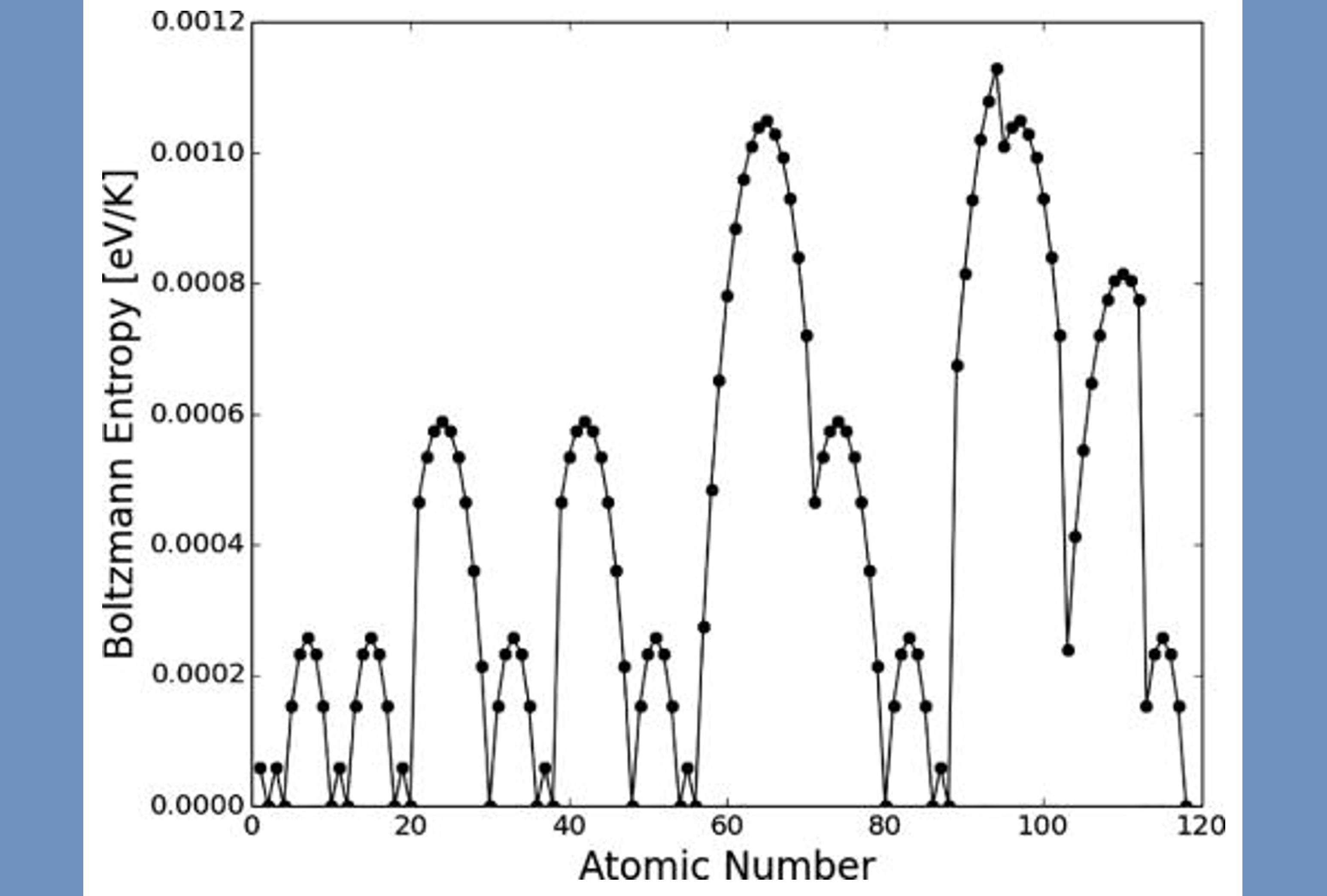
Bolzmann entropy of the electronic structure for each element in the periodic table based on permutations of electron configurations. Figure published in AVS Quantum Science and used via Creative Commons license.
Predicting the chemical and physical properties of a material is directly related to understanding the structure and interactions of its electrons. Understanding, modeling and predicting the material properties of lanthanides and actinides is challenging due to the complexity of their electronic structure.
In work published in AVS Quantum Science, Miles Beaux (MST-7) approached this complexity by applying statistical mechanics principles to the finite number of ways that electrons can arrange themselves in multiconfigurational ground states. In the paper, the method is compared to how thermodynamics is able to describe gas filling a room from statistical mechanical principles without having to account for position and moment of every single gas particle in the room. The work was described by one peer reviewer as “revolutionary” as it provides an entirely new way of looking at electronic structure complexity, not just for the lanthanides and actinides, but for all the elements in the periodic table.
Inspired by the work of Janoschek et al, who described the ground state of plutonium as being “governed by valence fluctuation, that is a quantum mechanical superposition of localized and itinerant electronic configurations,” Beaux considered what configurations could reasonably participate in a quantum mechanical superposition. All possible electron permutations for a given number of judiciously selected occupancy configurations for each element in the periodic table were considered and counted. By treating the total number of permutations as statistical mechanical microstates, Boltzmann’s entropy was calculated for each element. The entropies determined for each element are considered over-approximations, and initial comparison of the calculated entropies to known molar entropies for elements confirm this over-approximation for all solid elements.
The work leverages the Lab’s decades-long expertise in f-electron research, particularly for 5f-electron actinides.
Funding and mission
This material is based upon work supported by the U.S. Department of Energy Office of Science, Office of Basic Energy Sciences, Heavy Element Chemistry program. This research supports the Laboratory’s Global Security mission area and the Materials for the Future capability pillar.
Reference
“An over-approximation of entropy for elemental multiconfigurational ground state electronic structures,” AVS Quantum Science, 5, 020801 (2023); DOI: 10.1116/5.0146430. Author: Miles Beaux (Los Alamos National Laboratory).
Technical contact: Miles Beaux (MST-7)
Physics
First data for tantalum-180m decay search yields improved limits and constraints
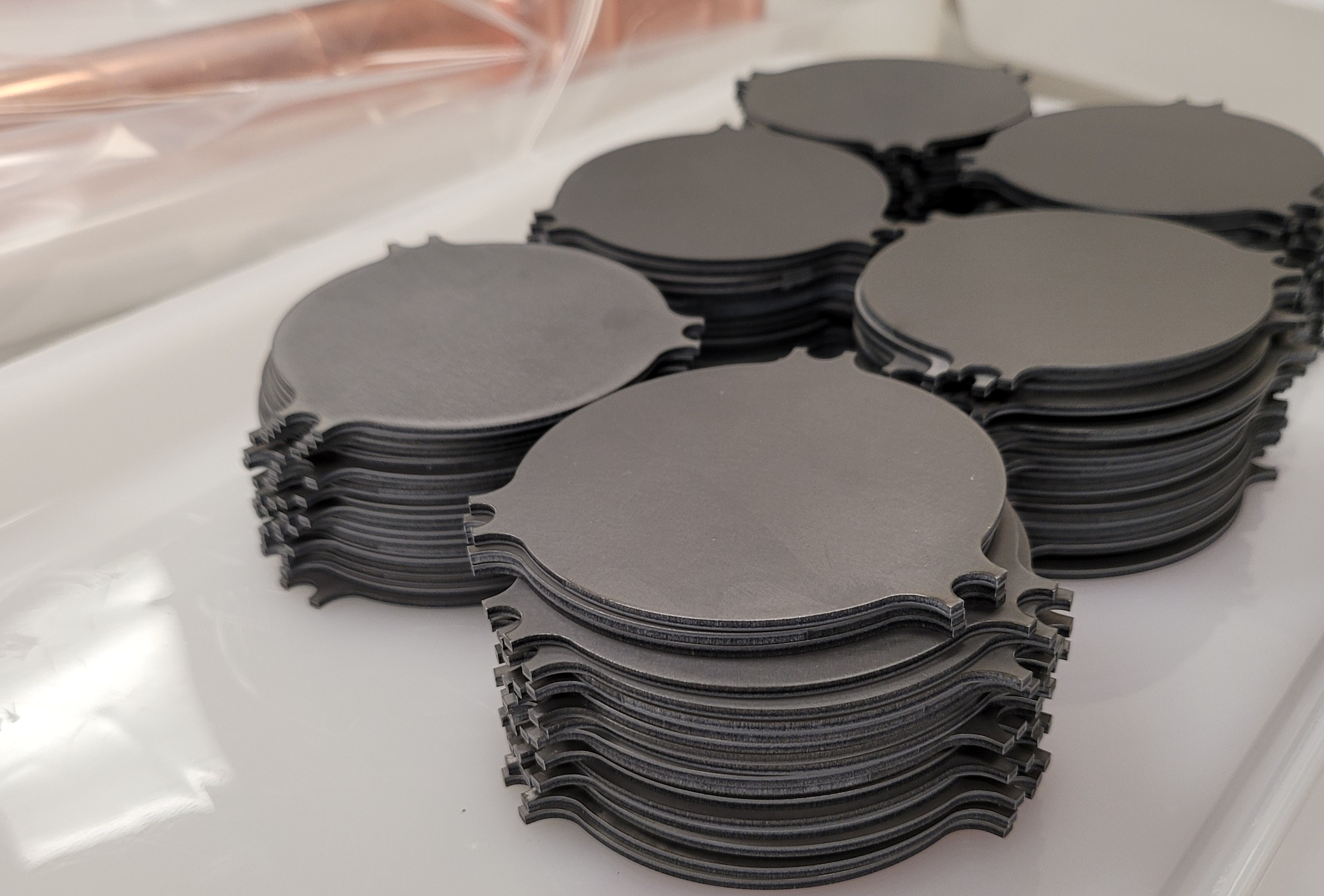
Tantalum is a rare stable metal, and Ta-180m is rarer still. The research team used 17 kilograms of tantalum — the most ever for this kind of search — which included 2 grams of Ta-180m.
Scientists at Los Alamos National Laboratory are leading the effort to observe the decay of tantalum-180m, believed to be the only naturally occurring isomer whose decay has not been observed. Ralph Massarczyk (P-1) and Sam Meijer (NEN-2), in collaboration with Daniele Alves (T-2), are leading the detector experiment at the Sanford Underground Research Facility, nearly 1 mile underground in a former gold mine in Lead, South Dakota. The results from the first year of data taking, recently published in Physical Review Letters, provide Ta-180m half-life limits that are updated and improved by one to two orders of magnitude. The efforts so far also represent the most sensitive searches for single beta and electron capture decay ever achieved.
An isomer forms if a nucleus is trapped in a longer-living state that is energetically above the ground state. The tantalum isotope only exists in its isomeric state due to quirks of its shape, quantum spin and the energy difference between the excited and low-energy states. This metastable state eventually decays into new isotopes by releasing energy and particles. The exact rate at which Ta-180m decays — the half-life — and an observation of the decay has eluded researchers for over 70 years. It has never been observed and remains an open puzzle piece in the scientific understanding of isomers.
While most nuclear states live femto or pico seconds, isomers can live for minutes, hours or even days. Tantalum drives this scale to the extremes and is the ultimate milestone to compare theoretical predictions to experimental values since small deviations will easily create observable differences. The first-year data show that the Ta-180m isomer half-life must be at least as long as 1.5x1019 years, about one billion times longer than the age of the universe itself. By measuring the signatures of the decay products the team can search for specific decay channels and rates. In addition to the traditional decay channels such as isomer transition to ground state, beta decay to an isotope of tungsten, and electron capture to an isotope of hafnium, the decay could be also triggered by certain dark-matter types, hence combining a classic nuclear physics problem with the search for new physics.
The element tantalum is a highly uncommon metal, found in less than two ten-thousandths of a percent in the Earth’s crust, making it the rarest stable metal in the solar system. The isomer tantalum-180m is rarer still, representing only 0.02 percent of tantalum. With the help of Los Alamos’ Laboratory Directed Research and Development program, the team purchased 17 kilograms of ultra-pure tantalum, the most ever for this kind of search, though that amount still contains just 2 grams of Ta-180m. To detect the gamma-ray signal of Ta-180m’s decay, they repurposed an array of high-purity germanium detectors from the Majorana Demonstrator, an experiment that searched for neutrinoless double-beta decay. The team used a set of specially fabricated tantalum discs and underground, electroformed copper that is among the cleanest ever fabricated. In a clean room 4,850 feet underground, the apparatus was assembled, vacuum sealed, cooled to cryogenic temperatures, and heavily shielded from outside or cosmogenic radiation using more than 50 tonnes of lead and copper.
The experiment will continue to take data through October 2024. Within this time frame, the team expect to collect enough data to observe the decay, if theoretical predictions are correct. While waiting for observation the team can use the data to exclude dark-matter candidates, complementary to ton-scale dark matter searches. Dark matter types that would dominantly interact through inelastic scattering are of especial interest for investigation since the extra energy from the isomeric state allows transitions into different states.
Funding and mission
This work was supported by the Laboratory Directed Research and Development program of Los Alamos National Laboratory and is based upon work supported by the U.S. Department of Energy, Office of Science, Office of Nuclear Physics. The work was further supported by the Particle Astrophysics Program and Nuclear Physics Program of the National Science Foundation, the South Dakota Board of Regents Competitive Research Grant, the Natural Sciences and Engineering Research Council of Canada, the Canada Foundation for Innovation John R. Evans Leaders Fund, and the 2020/2021 L’Oréal-UNESCO for Women in Science Program. The work supports the Global Security mission area and the Nuclear and Particle Futures capability pillar.
Reference
“Constraints on the Decay of 180mTa,” Physical Review Letters, 131, 152501 (2023); DOI: 10.1103/PhysRevLett.131.152501. Authors: I. J. Arnquist, E. W. Hoppe, R. T. Kouzes (Pacific Northwest National Laboratory); F. T. Avignone III, T. E. Lannen V., D. Tedeschi (University of South Carolina); A. S. Barabash (Kurchatov Complex of Theoretical and Experimental Physics, Moscow); C. J. Barton, T. K. Oli, L. S. Paudel, W. Xu (University of South Dakota); K. H. Bhimani, B. Bos, T. S. Caldwell, M. L. Clark, J. Gruszko, I. S. Guinn, C. R. Haufe, R. Henning, D. Hervas Aguilar, A. Li, A. L. Reine, J. F. Wilkerson (University of North Carolina, Chapel Hill); E. Blalock (North Carolina State University), M. Busch (Duke University), M. Buuck, J. A. Detwiler, A. Hostiuc, N. W. Ruof, C. Wiseman (University of Washington); S. J. Schleich, C. D. Christofferson, J. D. Thompson (South Dakota School of Mines and Technology); C. Cuesta (Centre for Energy, Environmental and Technological Research, Madrid); Yu. Efremenko (University of Tennessee), H. Ejiri (Osaka University); G. K. Giovanetti, A. Rouyer, T. A. Smith-Gandy (Williams College); M. P. Green (North Carolina State University); V. E. Guiseppe, J. M. López-Castaño, D. C. Radford, R. L. Varner, C.-H. Yu (Oak Ridge National Laboratory); W. Pettus (Indiana University); A. W. P. Poon (Lawrence Berkeley National Laboratory); H. Ramani (Stanford University); S. Vasilyev (Joint Institute for Nuclear Research, Dubna); D. S. M. Alves, P.-H. Chu, S. R. Elliott, J. Goett, L. Hebenstiel, I. Kim, R. Massarczyk, S. J. Meijer, K. Rielage, D. C. Schaper, S. L. Watkins (Los Alamos National Laboratory).
Technical contacts: Ralph Massarczyk (P-1) and Samuel Meijer (NEN-2)


